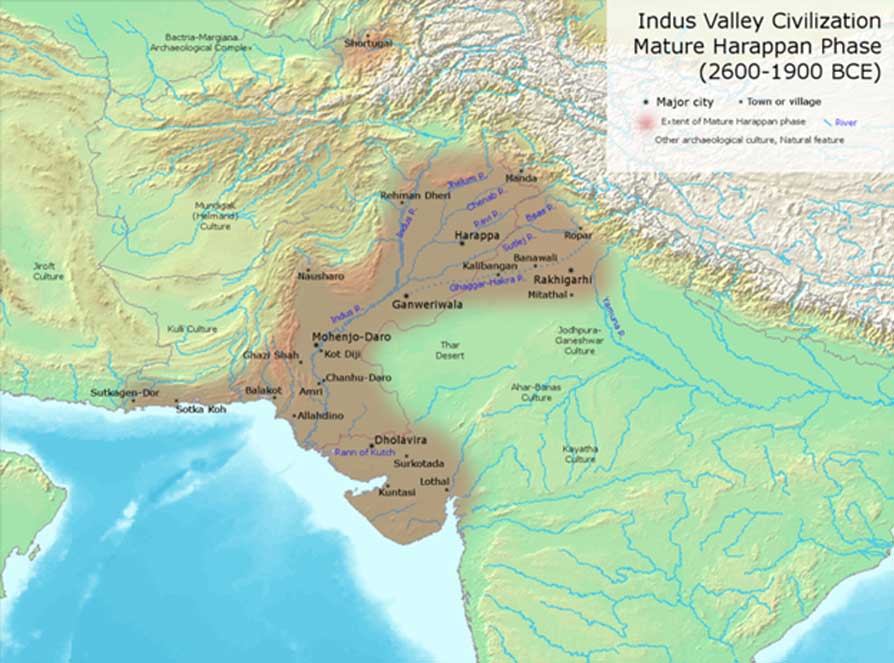
Bronze Age Indus Valley Civilization: The Spirit of Saraswathi
In the Rigveda, the ancient Indian Vedic Sanskrit canonical sacred texts, a hymn is dedicated to each deity and the goddess Saraswathi is revered as a female deity with healing and the purifying powers of abundant, flowing waters. Saraswathi is therefore also reference to a river and she embodies wisdom, music, language and purification of self. The Ghaggar-Hakra river is a monsoon fed perennial river in India and Pakistan, believed to be the mythological Sarasvati river, which formed a confluence with the Ganges and Yamuna, both considered sacred rivers. The Indus Valley Civilization is thus also referred to as the Sarasvati Civilization, in honor of the ‘river goddess’ Saraswathi.

Indus Valley Civilization major sites. (CC BY-SA 3.0)
Nestled between the Arabian Sea, mountain ranges and a desert in north-western South Asia, the Indus valley extends from what today is north-east Afghanistan to Pakistan and north-west India. The Indus Valley Civilization was contemporary to the Ancient Egyptian, Minoan (Crete) and Mesopotamian Bronze Age, particularly the Elamite, civilizations. In Sumerian texts, the Indus valley people are referred to as ‘Meluhhaites’ and the Indus valley is called ‘Meluhha’.
For an ancient civilization to be classified as Bronze Age (circa 3300 - 1200 BC) it either had to be smelting its own copper and alloying with tin or other metals to produce bronze, or it was involved in trading for or with bronze. Bronze Age civilizations had a technological advantage, since bronze is a hard metal. Besides metallurgical advancement, Bronze Age civilizations are also identified by the emergence of proto-writing or writing. In an Ancient-Origins article Natalia Klimczak discusses the finding that the Indus Valley Civilization is at least 8,000 years old, not 5,500 as previously believed, due to dating of the oldest pottery discovered.
Major Indus Valley Civilization Centers
Five million people lived, worked and prospered peacefully in the Indus valley, where Harappa and Mohenjo-Daro (in modern Pakistan) and Rakhigarhi in India, have been identified as major centers of sophisticated Bronze Age civilization. Whether they were independent city-states or part of a larger kingdom is not entirely clear. Archaeological excavations, initiated in 1861 and continuing since the 1920’s, indicate these cities had extensive sewerage and water supply systems, as well as town planning for the mud brick residential and large administrative buildings, smelting furnaces, granaries and dockyards. The world’s first hydraulic engineering originated from the Indus Valley Civilization. Hygiene was highly valued and although households collected water from wells, they had a bathroom, with a flushing toilet, where waste water was drained through a sewerage system to the streets.
In total more than 1,000 Indus valley settlements have been identified of which little more than half are situated in India and the rest in Pakistan. The Indus Valley Civilization stretched to north-eastern Afghanistan, with outposts on the Iranian border and even as far as Turkmenistan.
- The Extensive Indus Valley Sites of Gujarat
- Art Relics Shed Light on Mysterious Ancient Civilization
- Descendants of Indus Valley Builder Tribe May Soon Disappear, Taking Secret Knowledge with Them
Harappa
Harappa, situated on the banks of the Ravi river, was a fortified city, about 1502 hectares (1.52 kilometers) in size. It was already a flourishing city by 2600 BC. Unfortunately, the archaeological site was ransacked under British rule in 1857, when the engineers John and William Brunton used bricks from the ruins as track ballast in the construction of the Lahore–Multan Railway, despite British archaeologists conducting preliminary excavations there since 1826. In 1921 a formal archaeological excavation was underway, conducted by Sir John Hubert Marshal, Rai Bahadur Daya Ram Sahni and Madho Sarup Vats and a recent effort from the Pakistani archaeologist Ahmad Hasan Dani resulted in further restoration of the site.

Archaeological Site of Harappa (CC BY-SA 3.0)




